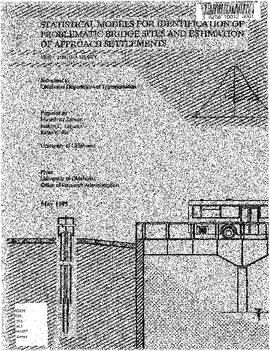| dc.description.abstract | Bridge approach settlement is caused by the differential movements of the bridge abutment and the approach pavement. The resulting unsafe riding surface not only requires frequent and costly maintenance but also leads to numerous traffic accidents. A number of factors contributing to such approach settlement have been identified, of which age of approach, embankment height, foundation soil thickness, skewness of approach, traffic volume, and the site-specific embankment and foundation soil characteristics are considered in the present study. The site-specific SPT and CPT values (viz. tip resistance and friction ratio) were used to represent the embankment and the foundation soil characteristics at a site. A statisticallybased model, using SAS package program, was developed based on the data from 2 6 bridge sites in Oklahoma. Also, a special "Field Test Model" was developed with the aim of identifying the problematic bridge sites prior to the construction of the bridge. The variables used in the field test model can be easily obtained from the SPT and CPT tests. The linear model was found to be more effective in identifying problematic sites as well as estimating approach settlements compared to the nonlinear model. The field test model seems to be more efficacious in identifying the problematic sites than estimating the approach settlements. The coefficient of correlation, R2 (adjusted), varied from about 0.88 to 0.94. It was observed that the site-specific SPT ( N-value), cone resistance ( qc), friction ratio and the thickness of the foundation soil have significant impact on estimating the approach settlements as compared to other variables of the models, indicating that the site-specific embankment and foundation soil characteristics are the most influential causative factors. | |
